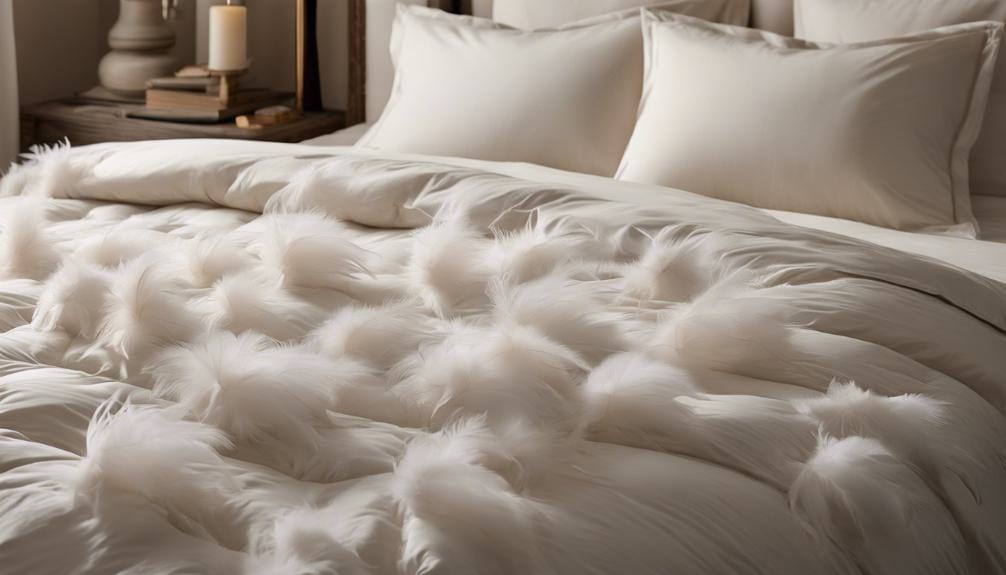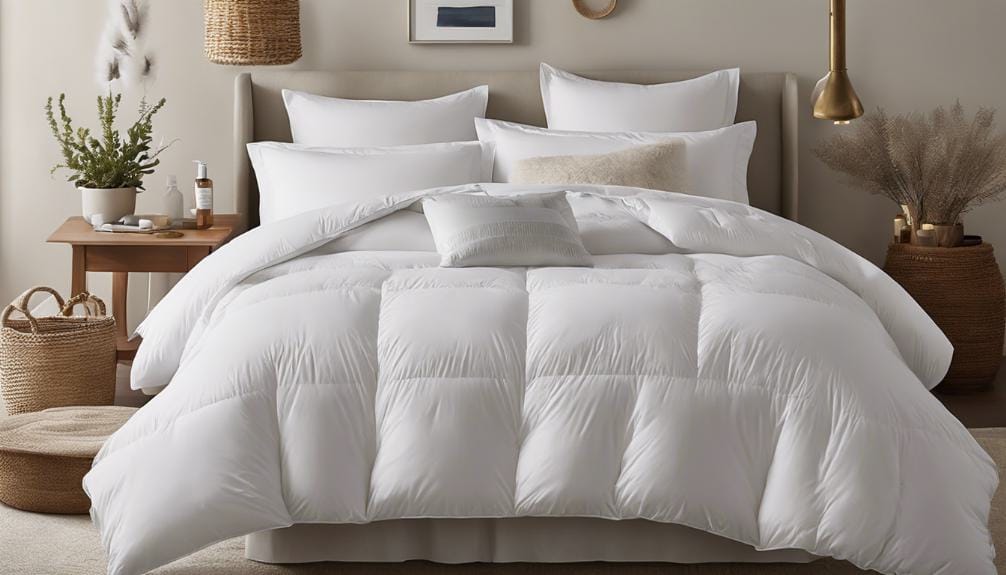How To Prevent Feathers From Coming Out Of Down Comforter? Simple Ways
If you've ever found feathers escaping from your down comforter, you know how frustrating it can be. To tackle this issue effectively, you'll want to contemplate a few simple strategies that can make a significant difference. By selecting the right duvet cover and maintaining your comforter's condition, you can minimize feather loss. But there's more to it than just that—understanding what causes this leakage in the first place can help you take proactive measures. What if there are additional materials and care tips that could improve your comforter's lifespan?
What Causes Feathers to Escape?

Whenever you utilize a down comforter, you might wonder what causes feathers to escape. The primary culprits are often related to the quality of the comforter and how you care for it. If your down comforter isn't made with a high thread count, the tightly woven fabric can't hold the feathers as effectively, leading to feather leakage.
Improper care can also contribute to this issue. For instance, at the time you wash your comforter at home, it may not receive the gentle treatment it needs. Excessive agitation during washing can cause the fabric to wear down, creating tiny openings for feathers to slip through.
Using a duvet cover is essential in the fight against feather escape. It acts as an extra barrier, catching any loose feathers and protecting your skin from sharp quills.
Regularly changing and washing the duvet cover helps maintain cleanliness and reduces the chances of feathers getting loose.
How to Use a Duvet Cover?
Using a duvet cover is a smart way to keep your down comforter protected while also adding a touch of style to your bedding.
It not only prevents feathers from escaping but also makes for easier cleaning and maintenance.
Benefits of Duvet Covers
A duvet cover offers numerous benefits that elevate your sleeping experience and maintain the longevity of your down comforter.
First and foremost, it acts as a protective layer, preventing feathers from escaping while also safeguarding your skin from sharp quills. This means you can enjoy the comfort of your down comforter without worrying about stray feathers.
Additionally, a duvet cover makes cleaning a breeze. You can easily remove and wash it, ensuring your bedding stays fresh and free from allergens.
Regularly changing the duvet cover is essential for proper care, as it minimizes dirt and sweat buildup on your comforter.
When selecting a duvet cover, consider one with a high thread count. This feature boosts durability and reduces the likelihood of feather leakage.
A cover with a tight weave will keep your comforter secure while also adding a touch of elegance to your bedroom décor.
Choosing the Right Fabric
In regard to choosing the right fabric for your duvet cover, you'll want to take into account both comfort and durability. A duvet cover serves as a protective barrier for your down comforter while enhancing your sleep experience. Look for materials with a high thread count, as this means a tighter weave that helps keep those pesky feathers contained.
Here are some factors to reflect upon while selecting your duvet cover fabric:
- Softness: You want something that feels great against your skin.
- Durability: Choose fabrics that can withstand regular wear and washing.
- Breathability: Opt for materials that allow air circulation to keep you comfortable.
- Easy Maintenance: Fabrics that can handle proper care will save you time and effort.
- Aesthetic Appeal: Select colors and patterns that match your bedroom decor.
Quality materials in your duvet cover can greatly affect your overall sleep quality. At the time you invest in the right outer fabric, you not only protect your comforter but also create a cozy sanctuary that you'll love curling up in every night.
Maintenance Tips for Duvet Covers
To keep your duvet cover looking fresh and functional, regular maintenance is key.
First, always use a duvet cover made from materials with a high thread count. This tighter weave not only improves comfort but also helps prevent feathers from escaping your down comforter.
Make it a habit to wash your duvet cover regularly, following the care instructions on the label. Most covers can be machine washed, but check to verify you're using the right water temperature and cycle.
For added protection, consider using a protective liner over your comforter before inserting it into the duvet cover. This extra layer can help contain any rogue feathers and extend the life of both the cover and the comforter.
If you notice any damage, such as small tears or holes, repair damage promptly. Hand sewing or using iron-on patches can prevent further feather loss and make sure your duvet cover remains functional.
What Materials to Choose?

When picking out a down comforter, the materials you choose play a vital role in preventing feather leakage. A high thread count in the outer fabric creates a tighter weave, reducing the chances of feathers escaping.
Additionally, baffle box construction helps keep the fill evenly distributed, further minimizing shifting and potential loss of feathers.
Importance of Thread Count
Choosing the right materials for your down comforter can greatly impact its performance and longevity, especially regarding thread count. A higher thread count in the outer material means tighter weaving, which helps prevent feathers from escaping. This is essential for maintaining the integrity of your down comforter.
When selecting a comforter, consider these factors that emphasize the importance of thread count:
- Durability: High-quality materials withstand wear and tear, prolonging the comforter's life.
- Comfort: A tighter weave feels softer against your skin.
- Feather Retention: Minimizes the chances of down leakage, keeping your bed cleaner.
- Allergen Prevention: Higher thread counts can help keep allergens out.
- Easy Maintenance: Following care instructions is simpler with durable fabrics.
Best Fabrics for Comforters
Selecting the best fabrics for your comforter greatly affects its overall performance and comfort. In terms of down comforters, you'll want to prioritize materials that offer durability while preventing feather leakage. Look for cotton fabrics with a high thread count; this tighter weave not only improves softness but also keeps those pesky feathers from escaping.
Opting for a duvet cover is another smart choice. Not only does it protect your comforter from wear and tear, but it also acts as an extra barrier against feather loss. Choose duvet covers made from breathable materials to guarantee comfort year-round.
Proper care is essential, too. Regularly fluffing your comforter helps maintain its shape and can reduce feather leakage. If you find any holes or tears, repair them quickly to avoid further loss.
Lastly, avoid washing your down comforter at home. Experts recommend dry cleaning to prevent clumping and feather escape. If you must wash it, stick to a front-loading machine, and skip the spin cycle.
Baffle Box Construction Explained
Baffle box construction is a key feature in high-quality down comforters that boosts their performance and longevity.
This method involves creating internal fabric walls that keep the down evenly distributed throughout the comforter, which helps mitigate feather loss.
When choosing materials, consider the following:
- High thread count: Opt for fabrics with a higher thread count to create a tighter weave, minimizing the chances of feathers escaping.
- Durable fabrics: Select materials like cotton or microfiber, as they provide a protective layer and improve comfort.
- Breathable materials: Look for options that allow airflow, keeping your comforter from getting too hot.
- Machine-washable options: Confirm that the fabric can withstand regular washing to maintain hygiene and appearance.
- Quality stitching: Check for reinforced seams to prevent wear and tear over time.
How to Care for Your Comforter?
To keep your down comforter in top shape, regular care is essential.
Fluffing it daily not only improves its loft but also prevents matting, which can lead to feather leakage.
Don't forget to use a protective liner and address any tears right away to keep your comforter cozy and intact.
Fluffing Techniques
Each morning, taking a few moments to fluff your down comforter can make a significant difference in its longevity and comfort.
As you fluff regularly, you help maintain the loft of the down fill, which prevents matting and minimizes feather leakage. Here are some simple techniques to keep your comforter in top shape:
- Shake it out: Give your comforter a good shake to redistribute the down evenly.
- Toss it on the bed: As you make your bed, throw the comforter over and smooth it out.
- Use your hands: Gently knead and fluff the fabric to separate the down clusters.
- Store properly: When not in use, store your comforter in a breathable bag to avoid compression.
- Repair damage promptly: If you spot any holes or tears, fix them immediately to prevent feathers from escaping.
Incorporating proper care and maintenance, including using a duvet cover and choosing high-quality materials, will improve your comforter's lifespan.
Using a Protective Liner
Adding a protective liner to your down comforter is a smart way to improve its durability and prevent feather leakage. This additional layer acts as a barrier, ensuring that any stray feathers stay contained and don't escape into your duvet cover or onto your bedding.
When selecting a protective liner, look for one that's zippered for better coverage. Pairing it with a duvet cover made from high thread count fabric boosts protection, as tighter weaves reduce feather leakage while adding a soft touch.
Regularly washing the duvet cover and the protective liner is essential for proper care and maintenance, keeping everything clean and fresh.
You should also remember to fluff your comforter regularly, as this helps maintain its shape and prevents matting, which can lead to feather loss.
Incorporating these practices won't only extend the life of your comforter but also improve your sleeping experience. With a protective liner in place, you can rest easy knowing you're taking proactive steps to keep your comforter in top condition, allowing you to enjoy the cozy warmth without the hassle of errant feathers.
Repairing Damage Quickly
A small tear in your down comforter can quickly lead to a flurry of feathers escaping, making prompt repairs essential. If you notice any damage, don't wait—repair damage promptly to maintain the comfort of your bedding.
Here's how you can tackle those pesky tears:
- Use a needle and thread: Hand sewing is straightforward and effective for small holes.
- Iron-on patches: These can be a quick fix and provide a secure seal against further feather loss.
- Fabric glue: For a no-sew option, fabric glue can work well on minor rips.
- Duct tape: In a pinch, duct tape provides an emergency hold until you can make a more permanent repair.
- Professional help: If the damage is extensive, consider taking your comforter to a professional for repairs.
Regular maintenance and immediate attention to any tears will help keep your down comforter fluffy and intact.
Should You Wash Your Comforter?

In terms of washing your down comforter, you might wonder whether to take the dry cleaning route or attempt it at home.
While dry cleaning can be gentler and help maintain the integrity of the filling, knowing the best practices for washing at home can save you time and money.
Let's explore the pros and cons of each method, along with tips for using your washer and dryer effectively.
Dry Cleaning vs. Home Washing
Deciding between dry cleaning and home washing for your down comforter can greatly impact its longevity and performance. While it might be tempting to toss it in your home washing machine, doing so could lead to clumping and feather leakage.
Dry cleaning is often the safer option, especially for high-quality materials.
Consider these factors when making your choice:
- Preservation: Proper care helps maintain the comforter's fluffiness and warmth.
- Feather retention: Dry cleaning minimizes the risk of feathers escaping.
- Longevity: Regular dry cleaning can extend the life of your comforter.
- Convenience: Professional services handle repairs and damage, ensuring your comforter stays in top shape.
- Care instructions: Following manufacturer guidelines is essential for maintaining your comforter's quality.
If you choose home washing, make sure to use a front-loading machine and avoid the spin cycle.
Always repair damage promptly to prevent further feather loss. Ultimately, prioritizing proper care through dry cleaning will keep your down comforter in great condition, so you can enjoy its warmth and comfort for years to come.
Best Practices for Washing
Washing your down comforter can be a tricky endeavor, but knowing the best practices can help maintain its quality and comfort. Before you even think about tossing it in the washing machine, consider using a duvet cover. Not only does it protect your comforter from dirt and oils, but it also helps contain any feathers that may escape during cleaning.
If you decide to wash your comforter, look for one with a high thread count. This tighter weave reduces the chances of feathers leaking out.
In terms of proper care, avoid using a traditional washing machine if possible. Instead, opt for a front-loading model that can handle the bulk of the comforter without causing clumping.
Be mindful of the drying process as well; consider using professional assistance if you're unsure. Dry cleaning is often recommended for down comforters, as it can prevent damage.
If you must wash it at home, use a gentle cycle and avoid the spin cycle to minimize feather loss.
With these best practices, you can keep your comforter cozy and intact for years to come.
Tips for Using a Washer and Dryer
Maintaining the integrity of your down comforter often depends on how you approach using a washer and dryer.
While washing machines can help keep your bedding fresh, improper care can lead to feather leakage. Here are some essential tips:
- Always use a duvet cover. This adds a protective barrier and minimizes direct exposure to the washing machine.
- Choose high-quality materials. Verify your comforter's outer fabric has a high thread count to prevent feathers from escaping.
- Handle with care. If you decide to wash it, use a front-loading machine to reduce agitation and avoid the spin cycle to prevent clumping.
- Dry carefully. Use a dryer on a low heat setting, adding clean tennis balls to help fluff the down and prevent it from clumping.
- Stay vigilant. Regularly check for wear and tear. Promptly repair any holes to avoid further feather loss.
Frequently Asked Questions
Can Feathers Escape From Any Type of Down Comforter?
Yes, feathers can escape from any type of down comforter, especially if it's poorly constructed or made from low-quality materials. You'll want to choose high-quality options and maintain them properly to minimize feather loss.
How Often Should I Wash My Duvet Cover?
You should wash your duvet cover every two to four weeks, depending on usage. If you sweat a lot or have allergies, consider washing it more frequently to maintain cleanliness and freshness.
What Is Baffle Box Construction in Down Comforters?
Baffle box construction involves stitching fabric walls between compartments in your down comforter. This design keeps the filling evenly distributed, preventing clumping and minimizing feather loss, which improves both comfort and durability for your bedding.
Are Synthetic Down Alternatives Less Likely to Shed?
Yes, synthetic down alternatives are generally less likely to shed. They're designed to mimic down without the feather issues, offering a more durable option that maintains its structure and comfort without the risk of loss.
How Do I Know if My Comforter Needs Repair?
You'll know your comforter needs repair if you spot holes, tears, or significant feather leakage. Also, if the fill feels uneven or clumpy, it's time to address those issues to maintain comfort and quality.
In Conclusion
To keep your down comforter in top shape and prevent feather loss, invest in a high thread count duvet cover, fluff it regularly, and handle any damage promptly. Gentle care is key—consider dry cleaning and use a protective liner for added security. By following these straightforward tips, you'll not only guarantee your comforter lasts longer but also enjoy cozy, uninterrupted nights of sleep. Remember, a little maintenance goes a long way for your comfort and investment.
